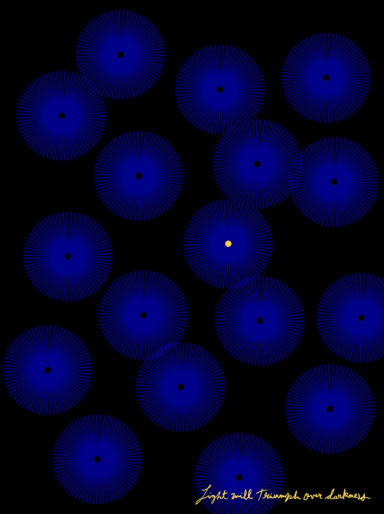

Stefan Kobel
,
Kobel's Art Weekly 17 2022
The largest art fair in the world with the most opaque sales conditions now also welcomes the paying public one week after opening for the professional public. A valuable guide is provided by Naomi Rea, who researched which gallery has placed represents which artist at the Biennale di Venezia for Artnet Pro (paywall). She comes up with more than 100 participating galleries, with David Zwirner with seven positions, followed by Massimo de Carlo with six and Sprüth Magers with five.
An appropriate card for the Biennial Bullshit Bingo was created by Hrag Vartanian for Hyperallergic - if not the most informed, then the most amusing journalistic contribution to the event.
Somewhat entertaining reviews by Alison Cole, José da Silva, Gareth Harris, Hannah McGivern and Tom Seymour of what they consider to be the worst exhibitions in Venice are bundled by The Art Newspaper. Probably all none of them media partners.
Raimar Stange asks the question of meaning in view of the Venetian business as usual at Artmagazine: "Instead, there is a celebration according to all the rules of art: Aperol Spritz, preview, party, bussies ... But the fact that there is war in Europe at the same time hardly bothers anyone, the Russian pavilion at least is closed." Birgist Rieger from the Tagesspiegel is also irritated: "The Preview Days are a big get-together of the international art scene. If the hedonistic art traveling circus didn't already feel ambivalent for climatic reasons - then at the latest now, when artists arrive only briefly from Kiev and then quickly return to the war. Taking a breather with Aperol Spritz by the canal. It's absurd."
As the majority of reporters were busy staging their cold and hot drinks by canals or posting the ever same Giardini and Arsenale photos, the Ukraine war made it into the media essentially through Ukrainian President Volodymyr Zelensky's video address during the opening of an exhibition organized by PinchukArtCentre at Scuola Grande della Misericordia, among others by Shanti Escalante-De Mattei at Artnews.
At least Frauke Steffens reports in the FAZ that the benefit auction of Marina Abramović and the Sean Kelly Gallery brought in 145,250 dollars.
A real art fair also took place last week with the Dallas Art Fair. There, Daniel Cassidy picked up signals of hope for The Art Newspaper: "'For years the market has changed in a way that excludes the middle-class collector,' the gallerist Cris Worley says. Especially after 2008, it was only the very wealthy that could drive the market. Now, things are changing. People are moving to more affordable cities because their jobs have moved to the remote model. They can go wherever they want. Starting in the summer of 2020 people started showing up to the gallery saying, 'I just moved here from California, from Chicago, from New York'. So many people are starting to collect art because now they have the means to. And these new collectors, they buy art because it moves them, not because of how much it sold for at auction last season. They buy art because they are in love the formal elements, because they love it.'"
Climate change seems to be becoming the biggest risk for art insurers, costing collectors dearly, notes Daniel Grant in The Art Newspaper: "Steven Pincus, senior managing director at Risk Strategies. [...] adds that some insurance companies are placing additional restrictions on transit coverage, which tends to be the single largest area of claims for damage, as a way of reducing their overall exposure. Increasingly, however, he says that 'companies are not writing new business and non-renewing in catastrophic-loss prone states, California being the most prominent'. Among those companies, he notes, are AIG, Chubb, Cincinnati and Vault. 'They want to eliminate exposure from their books, and the only way to stop the bleeding is to stop writing policies.'"
The establishment of a monthly sea freight service for art between London and New York by Christie's and the logistics company Crozier is reported by Eileen Kinsella at Artnet.
Bettina Wohlfarth reports from the Paris auction market in the FAZ with a sales report on the Matisse auction: "For the 78 lots - five remained unsold - more than 40 million euros were fetched with the premium at Christie's in Paris: almost double the expectation. The 29 works by Henri Matisse alone fetched 13.7 million euros, including many drawings, most of which were knocked down well above the estimate.
The Künstlersozialkasse, or KSK for short, is designed to give self-employed artists a minimum of social security as well as access to health insurance. Since its introduction in 1981, the model has functioned more badly than well and is in urgent need of reform, as Kevin Hanschke notes in the FAZ of April 22: "Hamburg's Senator for Culture Carsten Brosda (SPD) is particularly active in the reform discussion: 'Federal cultural policy is faced with the task of taking care of the social security of artists,' he says. He believes new regulations are needed to address the difficulties artists face in the pandemic. But few of his proposals have made it into the federal government's program. The coalition agreement includes three points: easier access for artists to voluntary unemployment insurance, special regulations for employees who do not work continuously for the same employer, and tax-financed economic aid for the self-employed. This is not the big cultural policy throwdown. In 2021, Brosda made the proposal to introduce a short-time allowance for artists. He speaks of a 'work insurance' into which they can pay in phases of high income in order to be insured in phases of no income. This insurance is to be attached to the KSK. Criticism of this comes from the business associations."
semi-automatically translated